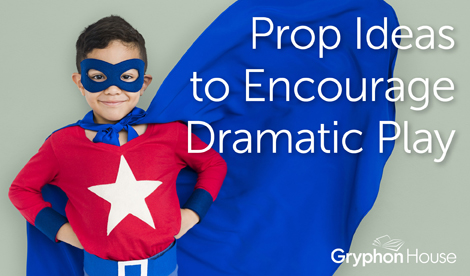

It is impossible to think of childhood without thinking of pretend play. We often laud young children’s imaginations and ability to make entire stories out of only a few random objects. That being said, symbolic play is more than just a leisure activity for young children; it is method of learning. The benefits of dramatic play include greater social-emotional awareness, improved motor skills, better communication, and overall greater confidence. Many educators are now reassessing the role of dramatic play in the classroom and are using it to teach everything from math to language!
Children are usually able to play with just about any object, but it is much easier and more stimulating when they have the proper props to help them truly create their dramatic play themes. A pretend bakery can be managed with a few bowls, but it’s so much more enriching and fun when the child also has an apron, a hat, some wooden spoons, and a play oven. Having a wide variety of props available lets children act out their original scenarios while providing inspiration for new dramatic play ideas. Prop Box Play: 50 Themes to Inspire Dramatic Play is an excellent resource for teachers looking for new ideas to add to the classroom prop box. Most of these props can be separated into three distinct categories.
Handling Props
Handling props are objects that children pick up and use during dramatic play. These can range from very specific to very vague. A comb, for example, would most likely be used in barber or beauty salon dramatic play, but little else, whereas a piece of curved PVC pipe could become a telephone, a microphone, an iron, etc. It’s best to have a mix of specific handling props and nonspecific ones to give children the most flexibility in their dramatic play. Often, children will seek something specific if they already know what they want to play. A four year old with his heart set on playing hairdresser may become frustrated if he cannot find a suitable comb or brush to use on a doll’s hair. Meanwhile, a child unsure of what she wants to play may look through the prop box and find some sticks and scarves and suddenly decide she wants to play magician. Having a variety of handling props facilitates creativity with both suggestion and accommodation.
The inclusion of handling props may also benefit certain skills that are important to the early childhood classroom. Motor skills are one. When children grab objects and hold them, they are practicing fine motor movements. This practice extends to using the objects for their intended purpose, like stirring with a spoon or moving a brush while pretending to paint. Having a variety of props encourages a variety of movements and possible textures, which stimulates cognitive development as well. Props also create opportunities for ideas like sharing and help children connect outside jobs and careers with the classroom.
Costume Props
As the name implies, these are the items in the prop box that can be worn. While that may sound intimidating to teachers—(after all, the average children’s Halloween costume runs for about thirty bucks nowadays)—these props don’t have to be full costumes. Often, a clothing prop box is made up of a mix of costume pieces, cheap children’s costumes, and just normal everyday clothes. Like the handling props, clothing props can be specific or nonspecific. It is the specific props that may get expensive, but thankfully there are many companies that specialize in providing clothes for children’s dress up. These costumes are usually much simpler than the average Halloween outfit, perhaps consisting of only a cheap vest decorated to look like occupational clothing. Nonspecific costumes can be found almost anywhere, from thrift shops to sale racks to your very own closet! A blue button down shirt can be applied to several different dramatic play themes, as can most shoes, simple pants, skirts, and aprons.
The benefit of costume props is that they make children feel their play is important. Uniforms and wearable items that denote roles are very powerful to young children; they represent that the child has a job to do and that people will take it seriously. That’s why children get so excited over stickers and stamps that tell them they are doing a good job; it validates their role in the classroom. This phenomenon carries into dramatic play. While a child will still play cop regardless of the props around him, that role takes on new importance when they are given a badge and a hat to wear. It makes the game seem more real, which leaves the child feeling his play is important. Costumes can also be used to introduce social and emotional skills since children may need to ask one another for help when putting a costume on, thus building trust and the importance of teamwork.
Setting Props
These props are the large objects that create a sense of place. Setting props include large pieces like toy ovens, chairs, desks, and carts. Since they are harder to recreate out of random objects, setting props have a special place in the dramatic play area. They make the situation feel more real, like costume props, but are also actively used by children, like handling props. This makes them rather indispensable. That being said, since setting props are so large, it’s best to keep them as versatile as possible. Only a few should be present in the play area, things like a countertop that can be used to play store, operation, post office, or any other scenario that utilizes a table or desk. Toy stoves and domestic kits are also useful, even if they are not as flexible as desks and chairs; often the first dramatic play theme children practice is “house”, so it’s best to have plenty of materials for that specific scene.
Setting props can be found in many places at a variety of prices. Garage sales and large thrift stores like Goodwill may have older versions of popular props like stoves and shopping carts. Teaching catalogues also tend to feature chairs and tables that are easy and safe for children to move. By setting up these props in the play area of the classroom, they become the center of a communal space that the children will share, which will facilitate social interaction and create a sense of community. While not as plentiful or various as other props, setting props are incredibly important and useful for dramatic play.
Dramatic play is an integral part of the childhood learning experience. As educators, it is a priority to make sure this play is nurtured properly, and that means providing the proper tools for it. Just like paper and pencils are necessary for academic learning, props are necessary for the social and cognitive learning dramatic play creates. With the right props, children prove that anything is possible with a little imagination.
Author(s)Blanche Desjean-Perrotta, Ann Barbour
A graduate of High Point University, Jenna Roby served as marketing specialist for Gryphon House from 2013-2015.